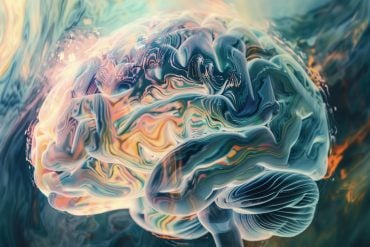Summary: Researchers report elephants are able to recognize their own bodies as obstacles to the success of a problem solving task.
Source: University of Cambridge.
Asian elephants are able to recognise their bodies as obstacles to success in problem-solving, further strengthening evidence of their intelligence and self-awareness, according to a new study from the University of Cambridge.
Self-awareness in both animals and young children is usually tested using the ‘mirror self-recognition test’ to see if they understand that the reflection in front of them is actually their own. Only a few species have so far shown themselves capable of self-recognition – great apes, dolphins, magpies and elephants. It is thought to be linked to more complex forms of perspective taking and empathy.
Critics, however, have argued that this test is limited in its ability to investigate complex thoughts and understanding, and that it may be less useful in testing animals who rely less on vision than other species.
One potential complement to the mirror test as a measure of self-understanding may be a test of ‘body-awareness’. This test looks at how individuals may recognise their bodies as obstacles to success in a problem-solving task. Such a task could demonstrate an individual’s understanding of its body in relation to its physical environment, which may be easier to define than the distinction between oneself and another demonstrated through success at the mirror test.
To test for body-awareness in Asian elephants, Dr Josh Plotnik, visiting researcher at the University of Cambridge, visiting assistant professor of psychology at Hunter College, City University of New York and founder of conservation charity Think Elephants International, devised a new test of self-awareness together with his colleague Rachel Dale (now a PhD student at the University of Veterinary Medicine in Vienna). The new test was adapted from one in which children were asked to push a shopping trolley, but the trolley was attached to a mat on which they were standing.
In the elephant version of the test, Plotnik and Dale attached a stick to a rubber mat using a rope; the elephants were then required to walk onto the mat, pick up the stick and pass it to an experimenter standing in front of them. The researchers wanted to investigate whether elephants understood the role of their bodies as potential obstacles to success in the task by observing how and when the animals removed themselves from the mat in order to exchange the stick. In one control arm of the test, the stick was unattached to the mat, meaning the elephant could pass the stick while standing on the mat.
The results of the study, which was largely funded by a Newton International Fellowship from the Royal Society awarded to Dr Plotnik, are published today in the journal Scientific Reports.
“Elephants are well regarded as one of the most intelligent animals on the planet, but we still need more empirical, scientific evidence to support this belief,” says Dale. “We know, for example, that they are capable of thoughtful cooperation and empathy, and are able to recognise themselves in a mirror. These abilities are highly unusual in animals and very rare indeed in non-primates. We wanted to see if they also show ‘body-awareness’.”
Plotnik and Dale found that the elephants stepped off the mat to pass the stick to the experimenter significantly more often during the test than during the control arm. Elephants stepped off the mat an average (mean) of around 42 out of 48 times during the test compared to just three times on average during the control.

“This is a deceptively simple test, but its implications are quite profound,” says Dr Plotnik. “The elephants understood that their bodies were getting in the way, so they stepped aside to enable themselves to complete the task. In a similar test, this is something that young children are unable to understand until they are about two years old.
“This implies that elephants may be capable of recognising themselves as separate from objects or their environment. This means that they may have a level of self-understanding, coupled with their passing of the mirror test, which is quite rare in the animal kingdom.”
Species that have demonstrated a capacity for self-recognition in the mirror test all show varying levels of cooperative problem-solving, perspective taking and empathy, suggesting that ‘self-awareness’ may relate to effective cooperative-living in socially intelligent animals. A more developed self-understanding of how an individual relates to those around may underlie more complex forms of empathic perspective taking. It may also underlie how an individual targets help towards others in need. Both aspect are seen in studies of human children.
Both self-awareness as demonstrated by the mirror test and body-awareness as demonstrated by the current study help scientists better understand how an animal’s understanding of self and of its place in the environment may impact social decision-making in the wild.
Plotnik argues that studies such as this are important for helping increase our understanding of and appreciation for the behaviour and intelligence of animals. He also says that understanding elephant behaviour has important implications for the development of human/elephant conflict mitigation strategies in places like Thailand and India, where humans and elephants are competing for land. Only through careful consideration of both human and elephant needs can long-term solutions be sustainable.
“The more we can understand about elephants’ behaviour, the more we can understand what their needs are, how they think and the strains they face in their social relationships,” he says. “This will help us if we are going to try to come up with viable long term solutions to the problems that these animals face in the wild, especially those that bring them into regular conflict with humans.”
Source: Craig Brierley – University of Cambridge
Image Source: NeuroscienceNews.com image is adapted from the University of Cambridge video.
Video Source: The video is credited to Cambridge University.
Original Research: Full open access research for “Elephants know when their bodies are obstacles to success in a novel transfer task” by Rachel Dale & Joshua M. Plotnik in Scientific Reports. Published online April 12 2017 doi:10.1038/srep46309
[cbtabs][cbtab title=”MLA”]University of Cambridge “Elephant’s “Body Awareness” Adds to Increasing Evidence of Their Intelligence.” NeuroscienceNews. NeuroscienceNews, 12 April 2017.
<https://neurosciencenews.com/elephant-intelligence-6395/>.[/cbtab][cbtab title=”APA”]University of Cambridge (2017, April 12). Elephant’s “Body Awareness” Adds to Increasing Evidence of Their Intelligence. NeuroscienceNew. Retrieved April 12, 2017 from https://neurosciencenews.com/elephant-intelligence-6395/[/cbtab][cbtab title=”Chicago”]University of Cambridge “Elephant’s “Body Awareness” Adds to Increasing Evidence of Their Intelligence.” https://neurosciencenews.com/elephant-intelligence-6395/ (accessed April 12, 2017).[/cbtab][/cbtabs]
Abstract
Elephants know when their bodies are obstacles to success in a novel transfer task
The capacity to recognise oneself as separate from other individuals and objects is difficult to investigate in non-human animals. The hallmark empirical assessment, the mirror self-recognition test, focuses on an animal’s ability to recognise itself in a mirror and success has thus far been demonstrated in only a small number of species with a keen interest in their own visual reflection. Adapting a recent study done with children, we designed a new body-awareness paradigm for testing an animal’s understanding of its place in its environment. In this task, Asian elephants (Elephas maximus) were required to step onto a mat and pick up a stick attached to it by rope, and then pass the stick forward to an experimenter. In order to do the latter, the elephants had to see their body as an obstacle to success and first remove their weight from the mat before attempting to transfer the stick. The elephants got off the mat in the test significantly more often than in controls, where getting off the mat was unnecessary. This task helps level the playing field for non-visual species tested on cognition tasks and may help better define the continuum on which body- and self-awareness lie.
“Elephants know when their bodies are obstacles to success in a novel transfer task” by Rachel Dale & Joshua M. Plotnik in Scientific Reports. Published online April 12 2017 doi:10.1038/srep46309






